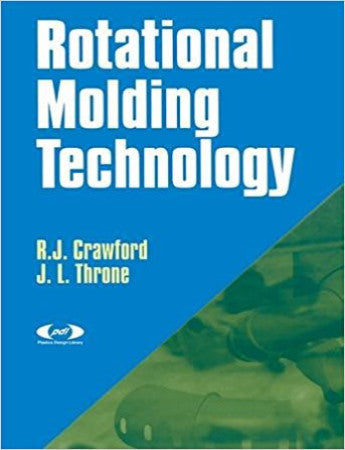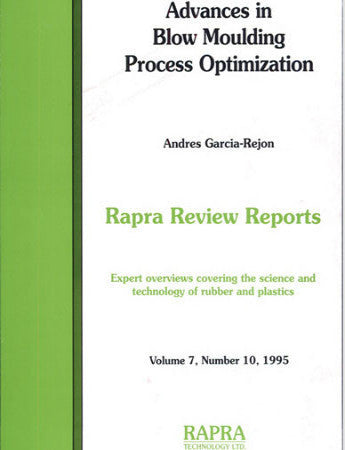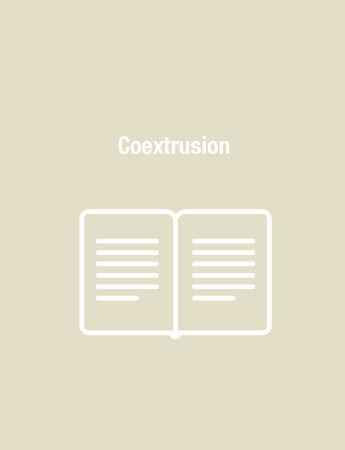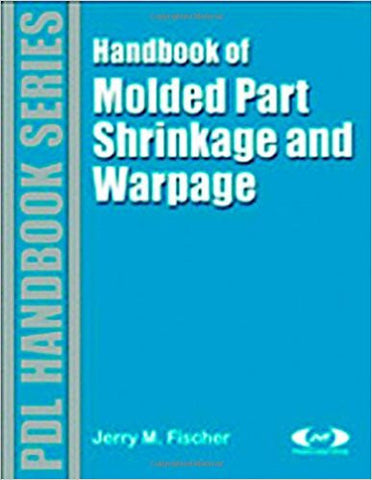Rotational Molding Technology
This book clarifies and quantifies many of the technical interactions in the process. It distinguishes itself from other books on the subject by being a seamless story of the advanced aspects of the rotational molding process. There are seven chapters within the book.
The U.S. market for rotational molding products was one billion pounds in the year 2000. The growth of the rotational molding industry has grown at 10 to 15% per year. With this growth has come an increasing need for details on the complex, technical aspects of the process.
The U.S. market for rotational molding products was one billion pounds in the year 2000. The growth of the rotational molding industry has grown at 10 to 15% per year. With this growth has come an increasing need for details on the complex, technical aspects of the process.
- Introduction to Rotational Molding
- A brief overview of the process and a comparison of rotational molding versus blow molding and twin-sheet thermoforming.
- Rotational Molding Polymers
- Describes the characteristics of polyolefins, which are the major class of polymers used in the process. It includes descriptions of vinyls, nylons, PVC plastisols, silicones, and thermosetting polymers.
- Pulverizing, Grinding and Attrition
- Focuses on the particle size of solid polymer powders, particle size distribution, particle analysis techniques, and optimum particle shape. It also details pigments and property enhancers.
- Rotational Molding Machines
- An overview of the myriad types of commercial rotational molding machines.
- Molds
- Compares materials such as steel, aluminum, and electroformed nickel in terms of their characteristic strength and thermal efficiencies. It also discusses mold design aspects and various mold releases.
- Processing
- Covers powder flow behavior, particle-to-particle adhesion, and densification as well as bubble removal, oven cycle time, and other mechanisms.
- Part Design
- Provides an overview of the technical aspects that influence the part design, including powder flow into and out of acute angles, and the effect of processing on properties and polymer characteristics.
R.J. Crawford is a Professor of Mechanical Engineering at the University of Auckland, New Zealand. He has published over 200 papers and is the author of five textbooks on plastics and engineering materials. He has been awarded numerous prizes for his research including the Netlon Medal from the Institute of Materials. James L. Throne is President of Sherwood Technologies, Inc., a polymer processing consulting firm he started in 1985. He has more than 20 years industrial experience, and taught for 10 years in universities. He has published nearly 200 technical papers, has nine patents, and has written eight books on polymer processing.
Related Products
Advances in Blow Mould...
$75.00
{"id":11242243972,"title":"Advances in Blow Moulding Process Optimization","handle":"978-1-85957-050-0","description":"\u003ch5\u003eDescription\u003c\/h5\u003e\nAuthor: Andreas Garcia-Jejon \u003cbr\u003eISBN 978-1-85957-050-0 \u003cbr\u003e\u003cbr\u003eIndustrial Materials Institute, National Research Council of Canada\u003cbr\u003e\u003cbr\u003e112 pages, softbound\u003cbr\u003e\n\u003ch5\u003eSummary\u003c\/h5\u003e\nReview of the current understanding of blow molding technology. The report is based on extensive literature review and includes a large number of references as well as abstracts covering a broad base of existing literature on the subject. The report discussed blow molding processes, materials used, application of products, a broad review of current research activities and expected future developments.\n\u003ch5\u003eTable of Contents\u003c\/h5\u003e\nBlow molding history \u003cbr\u003eExtrusion blow molding \u003cbr\u003eInjection and injection\/stretch blow molding \u003cbr\u003eMaterials and applications \u003cbr\u003eParison formation studies \u003cbr\u003eParison\/perform inflation studies \u003cbr\u003eCooling\/heating stage \u003cbr\u003eMaterial characterization \u003cbr\u003eFuture developments\u003cbr\u003e\u003cbr\u003e","published_at":"2017-06-22T21:14:55-04:00","created_at":"2017-06-22T21:14:55-04:00","vendor":"Chemtec Publishing","type":"Book","tags":["1995","book","characterization","extrudsion","extrusion blow molding","inflation","injection","molding","moulding","p-processing","parison","plastic","polymer","polymers","process"],"price":7500,"price_min":7500,"price_max":7500,"available":true,"price_varies":false,"compare_at_price":null,"compare_at_price_min":0,"compare_at_price_max":0,"compare_at_price_varies":false,"variants":[{"id":43378445700,"title":"Default Title","option1":"Default Title","option2":null,"option3":null,"sku":"","requires_shipping":true,"taxable":true,"featured_image":null,"available":true,"name":"Advances in Blow Moulding Process Optimization","public_title":null,"options":["Default Title"],"price":7500,"weight":1000,"compare_at_price":null,"inventory_quantity":1,"inventory_management":null,"inventory_policy":"continue","barcode":"978-1-85957-050-0","requires_selling_plan":false,"selling_plan_allocations":[]}],"images":["\/\/chemtec.org\/cdn\/shop\/products\/978-1-85957-050-0.jpg?v=1499719219"],"featured_image":"\/\/chemtec.org\/cdn\/shop\/products\/978-1-85957-050-0.jpg?v=1499719219","options":["Title"],"media":[{"alt":null,"id":350147051613,"position":1,"preview_image":{"aspect_ratio":0.767,"height":450,"width":345,"src":"\/\/chemtec.org\/cdn\/shop\/products\/978-1-85957-050-0.jpg?v=1499719219"},"aspect_ratio":0.767,"height":450,"media_type":"image","src":"\/\/chemtec.org\/cdn\/shop\/products\/978-1-85957-050-0.jpg?v=1499719219","width":345}],"requires_selling_plan":false,"selling_plan_groups":[],"content":"\u003ch5\u003eDescription\u003c\/h5\u003e\nAuthor: Andreas Garcia-Jejon \u003cbr\u003eISBN 978-1-85957-050-0 \u003cbr\u003e\u003cbr\u003eIndustrial Materials Institute, National Research Council of Canada\u003cbr\u003e\u003cbr\u003e112 pages, softbound\u003cbr\u003e\n\u003ch5\u003eSummary\u003c\/h5\u003e\nReview of the current understanding of blow molding technology. The report is based on extensive literature review and includes a large number of references as well as abstracts covering a broad base of existing literature on the subject. The report discussed blow molding processes, materials used, application of products, a broad review of current research activities and expected future developments.\n\u003ch5\u003eTable of Contents\u003c\/h5\u003e\nBlow molding history \u003cbr\u003eExtrusion blow molding \u003cbr\u003eInjection and injection\/stretch blow molding \u003cbr\u003eMaterials and applications \u003cbr\u003eParison formation studies \u003cbr\u003eParison\/perform inflation studies \u003cbr\u003eCooling\/heating stage \u003cbr\u003eMaterial characterization \u003cbr\u003eFuture developments\u003cbr\u003e\u003cbr\u003e"}
Coextrusion
$78.00
{"id":11242206020,"title":"Coextrusion","handle":"978-0-902348-71-4","description":"\u003ch5\u003eDescription\u003c\/h5\u003e\nAuthor: D. Djordjevic \u003cbr\u003eISBN 978-0-902348-71-4 \u003cbr\u003e\u003cbr\u003eKlöckner ER-WE-PA GmbH, Germany\u003cbr\u003eReview Report\u003cbr\u003e\u003cbr\u003e150 pages\u003cbr\u003e\n\u003ch5\u003eSummary\u003c\/h5\u003e\nIn this Review Report, he reviews sheet and profile extrusion, wire and cable coating and coinjection, describing both the rheological and structural considerations and the design and selection of machinery. Problems of layer instability and the measurement of layer thickness are addressed, as well as the selection of polymers and the recyclability of coextruded scrap.\n\u003ch5\u003eTable of Contents\u003c\/h5\u003e\n\u003cbr\u003eDefinition \u003cbr\u003eHistory \u003cbr\u003eCoextrusion Process \u003cbr\u003ePolymers \u003cbr\u003eCoextruded Structures \u003cbr\u003eCoextrusion Tools \u003cbr\u003eCoextrusion Dies \u003cbr\u003eLayer Distribution and Instability \u003cbr\u003eDetermination of Layer Thickness \u003cbr\u003eSelection of Polymers \u003cbr\u003eRecycling \u003cbr\u003eConclusions and Trends\u003cbr\u003e\u003cbr\u003e\n\u003ch5\u003eAbout Author\u003c\/h5\u003e\n\u003cp\u003eDragan Djordjevic has been R \u0026amp; D Manager with \u003cem\u003eKlöckner ER-WE-PA GmbH \u003c\/em\u003efor 15 years, and with over 70 papers and several patents to his name he is recognised worldwide as an expert in coextrusion and extrusion coating\u003c\/p\u003e","published_at":"2017-06-22T21:12:55-04:00","created_at":"2017-06-22T21:12:55-04:00","vendor":"Chemtec Publishing","type":"Book","tags":["1992","book","cable","coextrusion","coinjection","coinjection. extrusion","dies","p-processing","plastics","polymer","sheet profile","structures","thermoplastics","tools","wire","wire cable"],"price":7800,"price_min":7800,"price_max":7800,"available":true,"price_varies":false,"compare_at_price":null,"compare_at_price_min":0,"compare_at_price_max":0,"compare_at_price_varies":false,"variants":[{"id":43378321156,"title":"Default Title","option1":"Default Title","option2":null,"option3":null,"sku":"","requires_shipping":true,"taxable":true,"featured_image":null,"available":true,"name":"Coextrusion","public_title":null,"options":["Default Title"],"price":7800,"weight":1000,"compare_at_price":null,"inventory_quantity":1,"inventory_management":null,"inventory_policy":"continue","barcode":"978-0-902348-71-4","requires_selling_plan":false,"selling_plan_allocations":[]}],"images":["\/\/chemtec.org\/cdn\/shop\/products\/978-0-902348-71-4.jpg?v=1499211066"],"featured_image":"\/\/chemtec.org\/cdn\/shop\/products\/978-0-902348-71-4.jpg?v=1499211066","options":["Title"],"media":[{"alt":null,"id":353961115741,"position":1,"preview_image":{"aspect_ratio":0.767,"height":450,"width":345,"src":"\/\/chemtec.org\/cdn\/shop\/products\/978-0-902348-71-4.jpg?v=1499211066"},"aspect_ratio":0.767,"height":450,"media_type":"image","src":"\/\/chemtec.org\/cdn\/shop\/products\/978-0-902348-71-4.jpg?v=1499211066","width":345}],"requires_selling_plan":false,"selling_plan_groups":[],"content":"\u003ch5\u003eDescription\u003c\/h5\u003e\nAuthor: D. Djordjevic \u003cbr\u003eISBN 978-0-902348-71-4 \u003cbr\u003e\u003cbr\u003eKlöckner ER-WE-PA GmbH, Germany\u003cbr\u003eReview Report\u003cbr\u003e\u003cbr\u003e150 pages\u003cbr\u003e\n\u003ch5\u003eSummary\u003c\/h5\u003e\nIn this Review Report, he reviews sheet and profile extrusion, wire and cable coating and coinjection, describing both the rheological and structural considerations and the design and selection of machinery. Problems of layer instability and the measurement of layer thickness are addressed, as well as the selection of polymers and the recyclability of coextruded scrap.\n\u003ch5\u003eTable of Contents\u003c\/h5\u003e\n\u003cbr\u003eDefinition \u003cbr\u003eHistory \u003cbr\u003eCoextrusion Process \u003cbr\u003ePolymers \u003cbr\u003eCoextruded Structures \u003cbr\u003eCoextrusion Tools \u003cbr\u003eCoextrusion Dies \u003cbr\u003eLayer Distribution and Instability \u003cbr\u003eDetermination of Layer Thickness \u003cbr\u003eSelection of Polymers \u003cbr\u003eRecycling \u003cbr\u003eConclusions and Trends\u003cbr\u003e\u003cbr\u003e\n\u003ch5\u003eAbout Author\u003c\/h5\u003e\n\u003cp\u003eDragan Djordjevic has been R \u0026amp; D Manager with \u003cem\u003eKlöckner ER-WE-PA GmbH \u003c\/em\u003efor 15 years, and with over 70 papers and several patents to his name he is recognised worldwide as an expert in coextrusion and extrusion coating\u003c\/p\u003e"}
Handbook of Molded Par...
$260.00
{"id":11242222660,"title":"Handbook of Molded Part Shrinkage and Warpage","handle":"1-884207-72-3","description":"\u003ch5\u003eDescription\u003c\/h5\u003e\nAuthor: Jerry M. Fischer \u003cbr\u003eISBN 1-884207-72-3 \u003cbr\u003e\u003cbr\u003eTools and Troubleshooting, Inc., USA\u003cbr\u003e\u003cbr\u003epages 252, figures : 302\u003cbr\u003e\n\u003ch5\u003eSummary\u003c\/h5\u003e\nThis is the first and only handbook to deal with these fundamental problems. \u003cbr\u003e\u003cbr\u003eThe handbook explains in plain terms why moldings shrink and warp, shows how additives and reinforcements change the picture, sets out the effects of the molding process conditions, and reveals why you never can have a single \"correct\" shrinkage value. But, that's not all. The handbook shows you how to alleviate problems by careful design of the molded part and the mold, careful selection of materials, and proper process techniques. It examines computer-aided methods of forecasting shrinkage and warpage. And, most important of all, the handbook provides representative data to work with. \u003cbr\u003e\u003cbr\u003eThis is the most comprehensive collection of shrinkage data ever compiled in a book and includes hard-to-find multi-point information on how materials, part design, mold design processing, and post mold treatment affect the part's shrinkage and warpage. This book for all people who live and work with mold and shrinkage and warpage.\u003cbr\u003e\u003cbr\u003e\n\u003ch5\u003eTable of Contents\u003c\/h5\u003e\n1. Introduction to Plastics Processing\u003cbr\u003e1.1. Interactivity Basics \u003cbr\u003e1.2. Thermodynamic Principles Governing Injection Molding\u003cbr\u003e1.2.1 Filling\u003cbr\u003e1.2.2 Holding\u003cbr\u003e1.2.3 Cooling \u003cbr\u003e\u003cbr\u003e2. Shrinkage and Warpage\u003cbr\u003e2.1 Mold Shrinkage \u003cbr\u003e2.1.1 Determination of Shrinkage\u003cbr\u003e2.1.2 Molded-in Stress\u003cbr\u003e2.2 Warpage \u003cbr\u003e2.2.1 Common Causes of Non-Uniform Shrinkage\u003cbr\u003e2.2.2 principles of Minimizing Warpage \u003cbr\u003e2.3 Post-Mold Shrinkage \u003cbr\u003e\u003cbr\u003e3. Causes of Molded Part Variation - Part Design \u003cbr\u003e3.1 Wall Thickness\u003cbr\u003e3.2 Ribs\u003cbr\u003e3.3 Bosses\u003cbr\u003e3.4 Example of Proper Part Design\u003cbr\u003e3.5 Other Design Consideration \u003cbr\u003e\u003cbr\u003e4. Causes of Molded Part Variation - Material \u003cbr\u003e4.1 Amorphous and Semi-Crystalline Resins \u003cbr\u003e4.1.1 Amorphous Materials\u003cbr\u003e4.1.2 Semi-Crystalline Materials\u003cbr\u003e4.2 Effects of Fillers, Reinforcements, Pigments, Time and Stress\u003cbr\u003e4.2.1 Effects of Fillers and Fibers\u003cbr\u003e4.2.2 Minimizing the Effects of Fiber Reinforcements\u003cbr\u003e4.2.3 Effects of Pigments\u003cbr\u003e4.2.4 Effects of Time and Stress\u003cbr\u003e4.3 Shrinkage Prediction : Pressure-Volume-Temperature (PVT) Behavior \u003cbr\u003e4.3.1 PVT System Properties\u003cbr\u003e4.3.2 Predicting Mold Shrinkage\u003cbr\u003e4.3.3 Accuracy of Shrinkage Prediction \u003cbr\u003e\u003cbr\u003e5. Causes of Molded Part Variation - Mold Design \u003cbr\u003e5.1 Cavity Dimensions and Design Factors \u003cbr\u003e5.2 Gate Types\u003cbr\u003e5.2.1 Sprue Gate\u003cbr\u003e5.2.2 Pin, Pinpoint, Tunnel, and Submarine Gates\u003cbr\u003e5.2.3 Edge and Straight Gates\u003cbr\u003e5.2.4 Fan, Film, Diaphram, Ring, Disk, Cone, and Double-Sided Gates\u003cbr\u003e5.2.5 Multiple Gates\u003cbr\u003e\u003cbr\u003e5.3 Gate Location \u003cbr\u003e5.3.1 Side and End gates\u003cbr\u003e5.3.2 Determining Gate Position \u003cbr\u003e5.4 Gate Size \u003cbr\u003e5.5 Gate Design Systems\u003cbr\u003e5.6 Runner Design \u003cbr\u003e5.6.1 Multiple Cavity Molds\u003cbr\u003e5.6.2 Poor Ejection\u003cbr\u003e5.7 Mold Cooling Design\u003cbr\u003e5.7.1 Cooling Channels\u003cbr\u003e5.7.2 Effects of Corners\u003cbr\u003e5.7.3 Thickness Variations\u003cbr\u003e5.7.4 Runnerless Molds\u003cbr\u003e5.7.5 Slides\u003cbr\u003e5.7.6 Venting \u003cbr\u003e5.8 Mold Construction Materials\u003cbr\u003e5.9 Annealing \u003cbr\u003e5.10 Gas Assist \u003cbr\u003e5.11 Pitfalls to Avoid \u003cbr\u003e\u003cbr\u003e6. Causes of Molded Part Variation - Processing \u003cbr\u003e6.1 Molding Conditions\u003cbr\u003e6.1 (Injection melt Temperature) - if should be a separate section, renumber as 6.2 and renumber subsequent sections)\u003cbr\u003e6.2 Injection Rate\/Pressure\u003cbr\u003e6.2.1 Injection Speed\u003cbr\u003e6.2.2 Injection Pressure\u003cbr\u003e6.3 Holding Pressure\/Time\u003cbr\u003e6.3.1 Holding Pressure \u003cbr\u003e6.3.2 Holding pressure Time\u003cbr\u003e6.4 Mold Temperature\u003cbr\u003e6.4.1 Predicting mold Temperature Effects\u003cbr\u003e6.4.2 Relationship Between Mold Temperature and Wall Thickness\u003cbr\u003e6.5 Demolding Temperature\u003cbr\u003e6.6 Molded-in Stresses\u003cbr\u003e\u003cbr\u003e7. Factors Affecting Post-Mold Shrinkage\u003cbr\u003e7.1 Effects of Temperatures on Dimensions\u003cbr\u003e7.2 Effects of Moisture on Dimensions\u003cbr\u003e\u003cbr\u003e8. How to Control Mold and Post-mold Shrinkage and Warpage \u003cbr\u003e8.1 Find the Cause\u003cbr\u003e8.2 Part Geometry\u003cbr\u003e8.2.1 Overall Part Dimensions\u003cbr\u003e8.2.2 Wall Thickness\u003cbr\u003e8.2.3 Shrinkage Restricting Features\u003cbr\u003e8.3 Material Consideration\u003cbr\u003e8.3.1 Filler or Reinforcement Content\u003cbr\u003e8.3.2 Degree of Moisture Absorption\u003cbr\u003e8.4 Tooling Considerations \u003cbr\u003e8.4.1 Gate Locations\u003cbr\u003e8.4.2 Types and Sizes of Gates\u003cbr\u003e8.4.3 Runner Systems\u003cbr\u003e8.4.4 Mold Cooling Layout\u003cbr\u003e8.4.5 Tool Tolerances \u003cbr\u003e8.4.6 Draft Angles \u003cbr\u003e8.4.7 Ejection system Design\u003cbr\u003e8.4.8 Elastic Deformation of Mold\u003cbr\u003e8.4.9 Mold Wear\u003cbr\u003e8.4.10 Mold Contamination\u003cbr\u003e8.4.11 Position Deviations of Movable Mold Components\u003cbr\u003e8.4.12 Special Issues with Gears\u003cbr\u003e8.5 Processing Considerations\u003cbr\u003e8.5.1 Melt Temperatures and Uniformity \u003cbr\u003e8.5.2 Mold Temperatures and Uniformity \u003cbr\u003e8.5.3 Filling, Packing, and Holding Pressures\u003cbr\u003e8.5.4 Filling, Packing, and Holding Times\u003cbr\u003e8.5.5 Part Temperature at Ejection\u003cbr\u003e8.5.6 Clamp Tonnage\u003cbr\u003e8.5.7 Post-Mold Fixturing\/Annealing\u003cbr\u003e8.5.8 Special Problems with Thick Walls and Sink Marks\u003cbr\u003e8.5.9 Nozzles \u003cbr\u003e8.5.10 Excessive or Insufficient Shrinkage\u003cbr\u003e8.5.11 Secondary Machining\u003cbr\u003e8.5.12 Quality Control\u003cbr\u003e8.6 Controlling Warpage \u003cbr\u003e\u003cbr\u003e9. Computer Analysis\u003cbr\u003e9.1 How It Works\u003cbr\u003e9.1.1 Assumptions \u003cbr\u003e9.1.2 Generic Elements and Potential Limitations\u003cbr\u003e9.2 Does It Work \u003cbr\u003e9.2.1 Machine Settings and Controls\u003cbr\u003e9.2.2 Different Parts, Different Problems \u003cbr\u003e9.2.3 Differing Capabilities of Software\u003cbr\u003e9.3 What are Realistic Expectations of CAE?\u003cbr\u003e9.4 Resources\u003cbr\u003e9.4.1 How Much Does it Cost?\u003cbr\u003e9.4.2 Consultants \u003cbr\u003e9.5 OR Chapter 9 Appendix: Extended Illustration\u003cbr\u003e\u003cbr\u003e\u003cbr\u003e10. Case studies\u003cbr\u003e10.1 Unexpected Housing Shrink and Combing of the Glass Fibers\u003cbr\u003e10.2 Changing Materials Triggers Warpage \u003cbr\u003e10.3 Thin-Molded Lids\u003cbr\u003e10.4 Oversize Part Injection Molding Alkyd Thermoset\u003cbr\u003e10.5 Inadequate Mold: Baby Dish\u003cbr\u003e10.6 Gas Entrapment: Baby Dish\u003cbr\u003e10.7 Sprue and Runners\u003cbr\u003e10.8 Spool Mold \u003cbr\u003e10.9 Thermoplastic Engineering Design Study \u003cbr\u003e10.10 CDs\u003cbr\u003e10.11 Flat Parts\u003cbr\u003e10.12 Electronic Connectors\u003cbr\u003eData\u003cbr\u003eGlossary\u003cbr\u003eAbbreviations \u003cbr\u003eReferences\u003cbr\u003eIndex\u003cbr\u003e\u003cbr\u003e\n\u003ch5\u003eAbout Author\u003c\/h5\u003e\nJerry Fischer, CEO of Tools and Troubleshooting, Inc., brings to this handbook over 35 years experience as a mold designer and builder and consultant on mold shrinkage and warpage conditions. In the 1980s, Jerry published two books with McGraw-Hill on computer-aided design.","published_at":"2017-06-22T21:13:50-04:00","created_at":"2017-06-22T21:13:50-04:00","vendor":"Chemtec Publishing","type":"Book","tags":["2002","blow molding","book","compression molding","cooling","extrusion","fabrication","fillers","fluoropolymers","gate types","injection molding","injection rate","melt-processible","mold design","mould","moulding","p-processing","polymer","polymerization","reinforcement","rotational molding","shrinkage","tooling","transfer molding","tube","warpage","wire"],"price":26000,"price_min":26000,"price_max":26000,"available":true,"price_varies":false,"compare_at_price":null,"compare_at_price_min":0,"compare_at_price_max":0,"compare_at_price_varies":false,"variants":[{"id":43378376452,"title":"Default Title","option1":"Default Title","option2":null,"option3":null,"sku":"","requires_shipping":true,"taxable":true,"featured_image":null,"available":true,"name":"Handbook of Molded Part Shrinkage and Warpage","public_title":null,"options":["Default Title"],"price":26000,"weight":1000,"compare_at_price":null,"inventory_quantity":1,"inventory_management":null,"inventory_policy":"continue","barcode":"1-884207-72-3","requires_selling_plan":false,"selling_plan_allocations":[]}],"images":["\/\/chemtec.org\/cdn\/shop\/products\/1-884207-72-3.jpg?v=1499442251"],"featured_image":"\/\/chemtec.org\/cdn\/shop\/products\/1-884207-72-3.jpg?v=1499442251","options":["Title"],"media":[{"alt":null,"id":355727966301,"position":1,"preview_image":{"aspect_ratio":0.776,"height":499,"width":387,"src":"\/\/chemtec.org\/cdn\/shop\/products\/1-884207-72-3.jpg?v=1499442251"},"aspect_ratio":0.776,"height":499,"media_type":"image","src":"\/\/chemtec.org\/cdn\/shop\/products\/1-884207-72-3.jpg?v=1499442251","width":387}],"requires_selling_plan":false,"selling_plan_groups":[],"content":"\u003ch5\u003eDescription\u003c\/h5\u003e\nAuthor: Jerry M. Fischer \u003cbr\u003eISBN 1-884207-72-3 \u003cbr\u003e\u003cbr\u003eTools and Troubleshooting, Inc., USA\u003cbr\u003e\u003cbr\u003epages 252, figures : 302\u003cbr\u003e\n\u003ch5\u003eSummary\u003c\/h5\u003e\nThis is the first and only handbook to deal with these fundamental problems. \u003cbr\u003e\u003cbr\u003eThe handbook explains in plain terms why moldings shrink and warp, shows how additives and reinforcements change the picture, sets out the effects of the molding process conditions, and reveals why you never can have a single \"correct\" shrinkage value. But, that's not all. The handbook shows you how to alleviate problems by careful design of the molded part and the mold, careful selection of materials, and proper process techniques. It examines computer-aided methods of forecasting shrinkage and warpage. And, most important of all, the handbook provides representative data to work with. \u003cbr\u003e\u003cbr\u003eThis is the most comprehensive collection of shrinkage data ever compiled in a book and includes hard-to-find multi-point information on how materials, part design, mold design processing, and post mold treatment affect the part's shrinkage and warpage. This book for all people who live and work with mold and shrinkage and warpage.\u003cbr\u003e\u003cbr\u003e\n\u003ch5\u003eTable of Contents\u003c\/h5\u003e\n1. Introduction to Plastics Processing\u003cbr\u003e1.1. Interactivity Basics \u003cbr\u003e1.2. Thermodynamic Principles Governing Injection Molding\u003cbr\u003e1.2.1 Filling\u003cbr\u003e1.2.2 Holding\u003cbr\u003e1.2.3 Cooling \u003cbr\u003e\u003cbr\u003e2. Shrinkage and Warpage\u003cbr\u003e2.1 Mold Shrinkage \u003cbr\u003e2.1.1 Determination of Shrinkage\u003cbr\u003e2.1.2 Molded-in Stress\u003cbr\u003e2.2 Warpage \u003cbr\u003e2.2.1 Common Causes of Non-Uniform Shrinkage\u003cbr\u003e2.2.2 principles of Minimizing Warpage \u003cbr\u003e2.3 Post-Mold Shrinkage \u003cbr\u003e\u003cbr\u003e3. Causes of Molded Part Variation - Part Design \u003cbr\u003e3.1 Wall Thickness\u003cbr\u003e3.2 Ribs\u003cbr\u003e3.3 Bosses\u003cbr\u003e3.4 Example of Proper Part Design\u003cbr\u003e3.5 Other Design Consideration \u003cbr\u003e\u003cbr\u003e4. Causes of Molded Part Variation - Material \u003cbr\u003e4.1 Amorphous and Semi-Crystalline Resins \u003cbr\u003e4.1.1 Amorphous Materials\u003cbr\u003e4.1.2 Semi-Crystalline Materials\u003cbr\u003e4.2 Effects of Fillers, Reinforcements, Pigments, Time and Stress\u003cbr\u003e4.2.1 Effects of Fillers and Fibers\u003cbr\u003e4.2.2 Minimizing the Effects of Fiber Reinforcements\u003cbr\u003e4.2.3 Effects of Pigments\u003cbr\u003e4.2.4 Effects of Time and Stress\u003cbr\u003e4.3 Shrinkage Prediction : Pressure-Volume-Temperature (PVT) Behavior \u003cbr\u003e4.3.1 PVT System Properties\u003cbr\u003e4.3.2 Predicting Mold Shrinkage\u003cbr\u003e4.3.3 Accuracy of Shrinkage Prediction \u003cbr\u003e\u003cbr\u003e5. Causes of Molded Part Variation - Mold Design \u003cbr\u003e5.1 Cavity Dimensions and Design Factors \u003cbr\u003e5.2 Gate Types\u003cbr\u003e5.2.1 Sprue Gate\u003cbr\u003e5.2.2 Pin, Pinpoint, Tunnel, and Submarine Gates\u003cbr\u003e5.2.3 Edge and Straight Gates\u003cbr\u003e5.2.4 Fan, Film, Diaphram, Ring, Disk, Cone, and Double-Sided Gates\u003cbr\u003e5.2.5 Multiple Gates\u003cbr\u003e\u003cbr\u003e5.3 Gate Location \u003cbr\u003e5.3.1 Side and End gates\u003cbr\u003e5.3.2 Determining Gate Position \u003cbr\u003e5.4 Gate Size \u003cbr\u003e5.5 Gate Design Systems\u003cbr\u003e5.6 Runner Design \u003cbr\u003e5.6.1 Multiple Cavity Molds\u003cbr\u003e5.6.2 Poor Ejection\u003cbr\u003e5.7 Mold Cooling Design\u003cbr\u003e5.7.1 Cooling Channels\u003cbr\u003e5.7.2 Effects of Corners\u003cbr\u003e5.7.3 Thickness Variations\u003cbr\u003e5.7.4 Runnerless Molds\u003cbr\u003e5.7.5 Slides\u003cbr\u003e5.7.6 Venting \u003cbr\u003e5.8 Mold Construction Materials\u003cbr\u003e5.9 Annealing \u003cbr\u003e5.10 Gas Assist \u003cbr\u003e5.11 Pitfalls to Avoid \u003cbr\u003e\u003cbr\u003e6. Causes of Molded Part Variation - Processing \u003cbr\u003e6.1 Molding Conditions\u003cbr\u003e6.1 (Injection melt Temperature) - if should be a separate section, renumber as 6.2 and renumber subsequent sections)\u003cbr\u003e6.2 Injection Rate\/Pressure\u003cbr\u003e6.2.1 Injection Speed\u003cbr\u003e6.2.2 Injection Pressure\u003cbr\u003e6.3 Holding Pressure\/Time\u003cbr\u003e6.3.1 Holding Pressure \u003cbr\u003e6.3.2 Holding pressure Time\u003cbr\u003e6.4 Mold Temperature\u003cbr\u003e6.4.1 Predicting mold Temperature Effects\u003cbr\u003e6.4.2 Relationship Between Mold Temperature and Wall Thickness\u003cbr\u003e6.5 Demolding Temperature\u003cbr\u003e6.6 Molded-in Stresses\u003cbr\u003e\u003cbr\u003e7. Factors Affecting Post-Mold Shrinkage\u003cbr\u003e7.1 Effects of Temperatures on Dimensions\u003cbr\u003e7.2 Effects of Moisture on Dimensions\u003cbr\u003e\u003cbr\u003e8. How to Control Mold and Post-mold Shrinkage and Warpage \u003cbr\u003e8.1 Find the Cause\u003cbr\u003e8.2 Part Geometry\u003cbr\u003e8.2.1 Overall Part Dimensions\u003cbr\u003e8.2.2 Wall Thickness\u003cbr\u003e8.2.3 Shrinkage Restricting Features\u003cbr\u003e8.3 Material Consideration\u003cbr\u003e8.3.1 Filler or Reinforcement Content\u003cbr\u003e8.3.2 Degree of Moisture Absorption\u003cbr\u003e8.4 Tooling Considerations \u003cbr\u003e8.4.1 Gate Locations\u003cbr\u003e8.4.2 Types and Sizes of Gates\u003cbr\u003e8.4.3 Runner Systems\u003cbr\u003e8.4.4 Mold Cooling Layout\u003cbr\u003e8.4.5 Tool Tolerances \u003cbr\u003e8.4.6 Draft Angles \u003cbr\u003e8.4.7 Ejection system Design\u003cbr\u003e8.4.8 Elastic Deformation of Mold\u003cbr\u003e8.4.9 Mold Wear\u003cbr\u003e8.4.10 Mold Contamination\u003cbr\u003e8.4.11 Position Deviations of Movable Mold Components\u003cbr\u003e8.4.12 Special Issues with Gears\u003cbr\u003e8.5 Processing Considerations\u003cbr\u003e8.5.1 Melt Temperatures and Uniformity \u003cbr\u003e8.5.2 Mold Temperatures and Uniformity \u003cbr\u003e8.5.3 Filling, Packing, and Holding Pressures\u003cbr\u003e8.5.4 Filling, Packing, and Holding Times\u003cbr\u003e8.5.5 Part Temperature at Ejection\u003cbr\u003e8.5.6 Clamp Tonnage\u003cbr\u003e8.5.7 Post-Mold Fixturing\/Annealing\u003cbr\u003e8.5.8 Special Problems with Thick Walls and Sink Marks\u003cbr\u003e8.5.9 Nozzles \u003cbr\u003e8.5.10 Excessive or Insufficient Shrinkage\u003cbr\u003e8.5.11 Secondary Machining\u003cbr\u003e8.5.12 Quality Control\u003cbr\u003e8.6 Controlling Warpage \u003cbr\u003e\u003cbr\u003e9. Computer Analysis\u003cbr\u003e9.1 How It Works\u003cbr\u003e9.1.1 Assumptions \u003cbr\u003e9.1.2 Generic Elements and Potential Limitations\u003cbr\u003e9.2 Does It Work \u003cbr\u003e9.2.1 Machine Settings and Controls\u003cbr\u003e9.2.2 Different Parts, Different Problems \u003cbr\u003e9.2.3 Differing Capabilities of Software\u003cbr\u003e9.3 What are Realistic Expectations of CAE?\u003cbr\u003e9.4 Resources\u003cbr\u003e9.4.1 How Much Does it Cost?\u003cbr\u003e9.4.2 Consultants \u003cbr\u003e9.5 OR Chapter 9 Appendix: Extended Illustration\u003cbr\u003e\u003cbr\u003e\u003cbr\u003e10. Case studies\u003cbr\u003e10.1 Unexpected Housing Shrink and Combing of the Glass Fibers\u003cbr\u003e10.2 Changing Materials Triggers Warpage \u003cbr\u003e10.3 Thin-Molded Lids\u003cbr\u003e10.4 Oversize Part Injection Molding Alkyd Thermoset\u003cbr\u003e10.5 Inadequate Mold: Baby Dish\u003cbr\u003e10.6 Gas Entrapment: Baby Dish\u003cbr\u003e10.7 Sprue and Runners\u003cbr\u003e10.8 Spool Mold \u003cbr\u003e10.9 Thermoplastic Engineering Design Study \u003cbr\u003e10.10 CDs\u003cbr\u003e10.11 Flat Parts\u003cbr\u003e10.12 Electronic Connectors\u003cbr\u003eData\u003cbr\u003eGlossary\u003cbr\u003eAbbreviations \u003cbr\u003eReferences\u003cbr\u003eIndex\u003cbr\u003e\u003cbr\u003e\n\u003ch5\u003eAbout Author\u003c\/h5\u003e\nJerry Fischer, CEO of Tools and Troubleshooting, Inc., brings to this handbook over 35 years experience as a mold designer and builder and consultant on mold shrinkage and warpage conditions. In the 1980s, Jerry published two books with McGraw-Hill on computer-aided design."}




